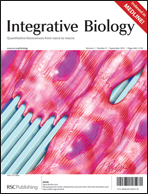Stem cell-based methods for myocardial regeneration suffer from considerable cell attrition. Artificial matrices reproducing mechanical and structural properties of the native tissue may facilitate survival, retention and functional integration of adult stem or progenitor cells, by conditioning the cells prior to, and during, transplantation. Here we combined autologous cardiosphere-derived cells (CDCs) with nanotopographically defined hydrogels mimicking the native myocardial matrix, to form in vitro cardiac stem cell niches, and control cell function and fate. These platforms were used to produce cardiac patches that could be transplanted at the site of infarct. In culture, highly anisotropic, but not more randomized nanotopographic, control augmented cell adhesion, migration, and proliferation. It also dramatically enhanced early, and, in the presence of mature cardiomyocytes, late cardiomyogenesis. Nanotopography sensing and transcriptional response was mediated via p190RhoGAP. In a rat infarction model, engraftment of nanofabricated scaffolds with CDCs enhanced retention and growth of transplanted cells, and their integration with the host tissue. The infarcted ventricle wall increased in thickness, with higher cell viability and better collagen organization. These results suggest that nanostructured polymeric materials that closely mimic the extracellular matrix structure on which cardiac cells reside in vivo can be both very effective tools in investigating the mechanisms of cardiac differentiation and the basis for cardiac tissue engineering, thus facilitating stem cell-based therapy in the heart.


 Please wait while we load your content...
Please wait while we load your content...